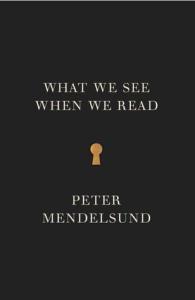 “Miss Brooke had that kind of beauty which seems to be thrown into relief by poor dress.” So begins Middlemarch. Your eyes, as you read those seventeen words, seemed to glide over them linearly, your mind to effortlessly flash on the meaning behind each one. Perhaps you began to generate an image of Dorothea Brooke. But now that I’ve called attention to the way you read, you might be experiencing a hiccup in the process. What if I tell you that the average person reads four to five hundred words a minute? Are you now trying to read just a tiny bit faster? What if I say that we don’t read linearly, but that our eyes “saccade” back and forth across a text block, taking in ten to twelve letters at a time?
“Miss Brooke had that kind of beauty which seems to be thrown into relief by poor dress.” So begins Middlemarch. Your eyes, as you read those seventeen words, seemed to glide over them linearly, your mind to effortlessly flash on the meaning behind each one. Perhaps you began to generate an image of Dorothea Brooke. But now that I’ve called attention to the way you read, you might be experiencing a hiccup in the process. What if I tell you that the average person reads four to five hundred words a minute? Are you now trying to read just a tiny bit faster? What if I say that we don’t read linearly, but that our eyes “saccade” back and forth across a text block, taking in ten to twelve letters at a time?
This “frantic career of the eyes,” as Proust called it, is the subject of Peter Mendelsund’s conversational yet deeply thought-provoking—or should I say thought-disrupting—book. He holds up the act of reading for the kind of scrutiny that typically must not happen in order for the enchantment to occur. Written in large type, with some pages containing only a sentence or a word, and interspersed with pictures and graphics of all kinds, What We See When We Read is like an animation of our reading process, but slowed down so that we can see each frame.
He starts with a thought experiment. Think of a novel you know well, either because you’ve read it many times or because you’ve read it recently. Now picture the main character as fully as you can. Peer into his or her face. Move him or her around on the stage of your mind.
How’d you do? Could you even do it? Perhaps you could only conjure a blurry, person-shaped form with just a few signal details like eye color or height. Or maybe, like me, you came up with a total blank, because your favorite character tells the story, and so when you read the novel, you don’t see Charles Kinbote peering over into his neighbor’s lawn in New Wye or Ishmael on the deck of the Pequod, so much as you inhabit his or mind, looking out from behind his or her eyes.
Don’t worry—this vagueness does not make you a bad reader. You are not betraying your favorite books by your inability to fully picture them. Mendelsund argues that, in fact, none of us ever picture the characters, scenes, or events of a novel when we read. He writes that we tell ourselves “a story called ‘Reading.’ We all know this story. It is a story of pictures, and of picturing.” But, he says, this story is incorrect because it is only “a remembered story. When we read, we are immersed. And the more we are immersed, the less we are able, in the moment, to bring our analytic minds to bear upon the experience in which we are absorbed.” The true story is at once more surprising and disquieting.
Mendelsund points out that it is the relative poverty of the reading experience—none of our senses are engaged beyond our visual apprehension of the characters on the page—that explains its power. The more that an author leaves out, the more our own imaginative faculties are recruited, so that we each co-create the novel. This is what invests the words with their depth and reality. As Rebecca Solnit says, “A book is a heart that only beats in the chest of another.”
So robust is our willingness to fill in the gaps that we can read even when we don’t fully comprehend, as when we read Anthony Burgess’s invented language of Nadsat in A Clockwork Orange, or the long passages of sailing argot in Arthur Ransome’s Swallows and Amazons. Mendelsund ticks off all of the things that don’t happen when we read, and builds to an overarching theory of why, despite the odds, reading works so magically.
The photographs and illustrations are too twee and detract from both the reading experience and the thesis of Mendelsund’s book, because he supplies that which he so insightfully observes that novels lack. But that sticking point aside, this is a book to read and talk about. Mendelsund’s book will surely disorder your thoughts as you watch yourself reading whatever novel you pick up after his book, but it is a productive disorder. He makes the room inside ourselves in which we read a little bit larger.
__
Amy Reading is the author of The Mark Inside: The Perfect Swindle, a Cunning Revenge, and a Short History of the Big Con.
